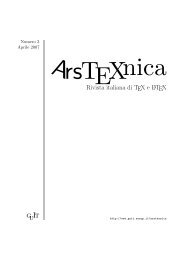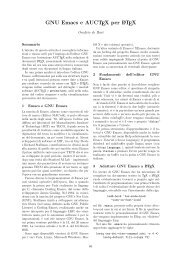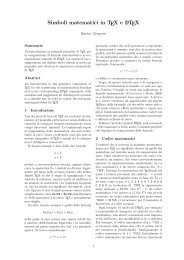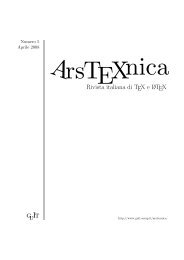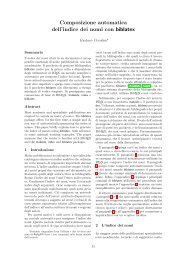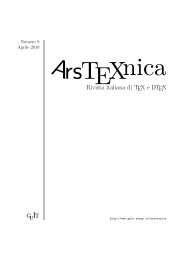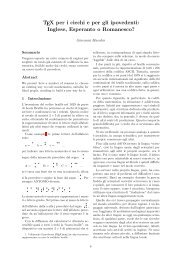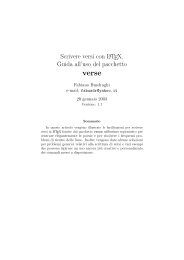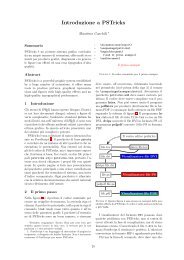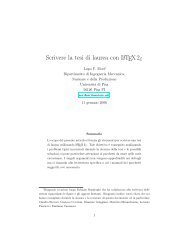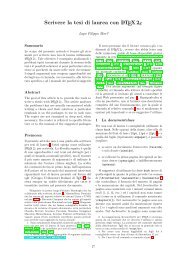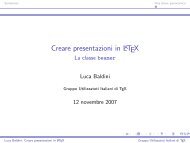Numero 2, 2006 - GuIT - Scuola Superiore Sant'Anna
Numero 2, 2006 - GuIT - Scuola Superiore Sant'Anna
Numero 2, 2006 - GuIT - Scuola Superiore Sant'Anna
You also want an ePaper? Increase the reach of your titles
YUMPU automatically turns print PDFs into web optimized ePapers that Google loves.
MlBibT E X’s Architecture<br />
ArsT E Xnica Nº 2, Ottobre <strong>2006</strong><br />
ENTRY {...}{...}{...} % Declaration of variables and functions.<br />
FUNCTION {...}{...}<br />
...<br />
FUNCTION {article}{...}<br />
...<br />
MACRO {oct}{"October"}<br />
...<br />
READ<br />
% Search bibliography data base .bib files for entries.<br />
... % Some preprocessing, including the sort of selected entries.<br />
SORT<br />
...<br />
EXECUTE {begin.bib} % Preamble and \begin{thebibliography}.<br />
EXECUTE {...}<br />
% Some initialisations.<br />
ITERATE {call.type$} % Loop over entries producing outputs.<br />
EXECUTE {end.bib} % Write \end{thebibliography} command.<br />
Figure 1: Bibliography style file used by BibT E X: framework and basic flow.<br />
in (Mittelbach et al., 2004, § 13.6.2). To sum<br />
up: once the citation keys and the bibliography<br />
style are known, the latter is run. The result is<br />
a .bbl file containing a thebibliography environment<br />
((Mittelbach et al., 2004, § 12.1.2)), each<br />
reference being prefixed by means of the \bibitem<br />
command.<br />
1.2 Going further<br />
At a first glance, a successor of BibT E X might<br />
conserve the same modus operandi. That is not<br />
always possible. BibT E X never reads the .tex file<br />
because the information it needs can be found in<br />
.aux files only. The same behaviour is unsuitable for<br />
MlBibT E X—as a program managing multilingual<br />
bibliographies—when it generates a ‘References’<br />
section for a L A TEX source text. Let us consider the<br />
following title, which uses a syntactical extension<br />
provided by MlBibT E X:<br />
TITLE = {[Danse macabre] : french}<br />
This book of Stephen King is written in English—<br />
of course—but its title uses French words, what is<br />
specified by the ‘[...] : french’ notation, where<br />
‘french’ is a language identifier (Hufflen (2003)).<br />
Let us assume that we are building a ‘References’<br />
section for a document in English. In order for<br />
L A TEX to use the right hyphenation patterns if<br />
need be, the .bbl file generated should include such<br />
a title as:<br />
\foreignlanguage{french}{Danse macabre}<br />
provided that the babel package is loaded with the<br />
french option when L A TEX processes this document<br />
((Mittelbach et al., 2004, Ch. 9)). First, there<br />
are several ways to write in French with L A TEX<br />
with the babel package or with other ad hoc packages.<br />
Second, let us recall that all the languages<br />
used throughout a document must be specified as<br />
options when the babel package is loaded. This<br />
package is static and the languages it uses cannot<br />
be extended dynamically. As we explain in Hufflen<br />
(2005a), there are several solutions to this<br />
problem, but we think that the best consists of<br />
analysing the preamble of the .tex file, in order to<br />
get information about the multilingual capabiblity<br />
chosen by a user. Let us go back to our title: if the<br />
french option has not been selected, MlBibT E X will<br />
just produce ‘Danse macabre’ and warn the user<br />
that some words may be incorrectly hyphenated.<br />
Another drawback of bibliography styles of<br />
BibT E X is that they are monolithic: one file for one<br />
style. There is a tool, custom-bib ((Mittelbach<br />
et al., 2004, § 13.5.2)), that allows a bibliography<br />
style to be build automatically from users’ wishes.<br />
But there is no modular approach in the sense that<br />
a style designer could develop a new style from<br />
existing style fragments. In MlBibT E X, a style is assembled<br />
dynamically, according to what is needed.<br />
For example, let us consider that a plain style 7 is<br />
to be used for a document written in English and<br />
including some fragments in Italian. The files that<br />
can be used are:<br />
plain.nbst general definitions for this style.<br />
plain-{english,italian}.nbst definitions suitable for<br />
the English and Italian languages and belonging<br />
to this style.<br />
{-english,-italian}.nbst general definitions for the<br />
English and Italian languages.<br />
So we need this information about available languages<br />
before applying a style.<br />
There is another difference, which can be noticed<br />
by an end-user, about abbreviations usable in a .bib<br />
file. Some may be defined using the @STRING{...}<br />
7. That is, items are labelled by numbers.<br />
55




